We’ve mentioned them several times in passing before, but today we are dedicating an entire post to what is undoubtedly our favourite bean that we have ever grown or eaten: the pea bean. We first started growing these five years ago, purely for their looks. But when we came to cook them we were won over – we’ve never gone a year without them since.
Although older textbooks sometimes classify them otherwise, pea beans are now categorised as Phaseolus vulgaris: French or ‘kidney’ beans. Pea beans are climbing beans that produce white flowers followed by short pods. The pods start flat but fill out quickly with delicious meaty beans, similar to broad beans in texture, but with thinner skins. These beans are very versatile and can be used to great effect at any stage from flat pod to plump bean.
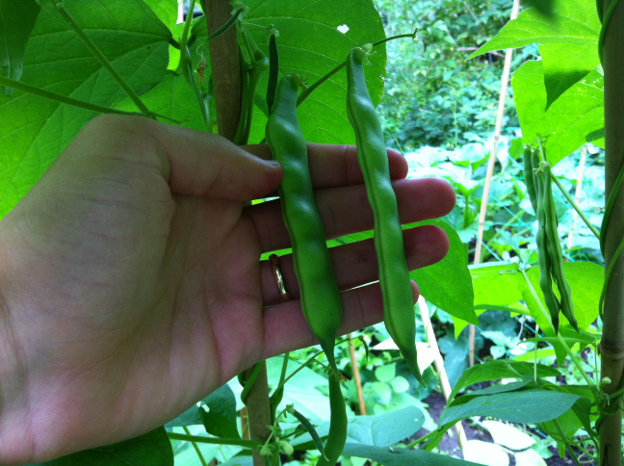
Pea beans growing in our vegetable patch.
In a conversation about French beans with a local smallholder a few years ago I mentioned that we always grow pea beans, half expecting that he would never have heard of them, as that had been my experience from every gardener/allotment holder that I had spoken to. To my delight he was very familiar with them. He said that he not only grew them, but that he preferred them to runner beans because they are high yielding, but unlike runner beans they never get stringy.
The fact that they don’t get stringy allows for the beans to be cooked and eaten in the pods even once the beans are fully formed. Alternatively at this stage the beans can be podded and used in soups, stews or curries. We allow a lot of ours to dry on the plant and shell them once fully dried to be used over the winter. We then leave them to soak overnight, rinse them and use them as though fresh. Using them before the beans are fully formed will of course encourage a higher yield, so early in the season we tend to use the pods whilst young and treat them like any other French bean.
The appearance of the bean is very striking. As can be seen in the image at the top of this post, when dried the bean is half maroon and half white. Our beans for winter storage look like this. However, if the beans are podded whilst still fresh the markings are almost invisible and the beans are green.
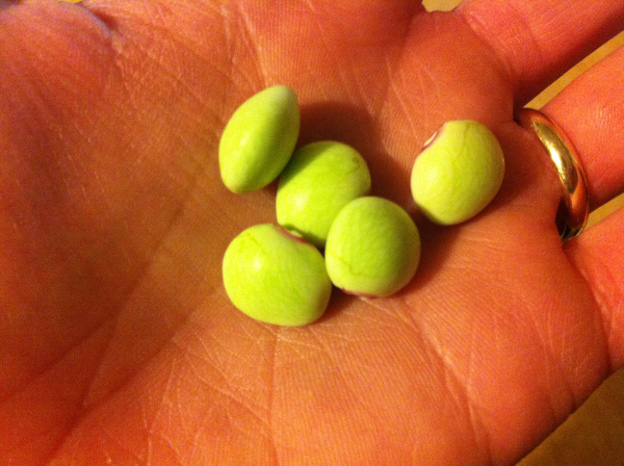
Podded fresh pea beans – almost unrecognisable from their dried state.
However, cooking the bean brings out the markings and the colours somewhat return, although not as vividly as in the bean’s dried state. This is demonstrated in the image below: what was a green fresh pea bean cooked in a stew. In case you were wondering the stew in the photo was Hugh Fearnley-Whittingstall’s porotos granados (Chilean squash stew) recipe from his excellent River Cottage Veg Everyday! book. The recipe almost followed to the letter, except for the addition of our home-grown runner beans.
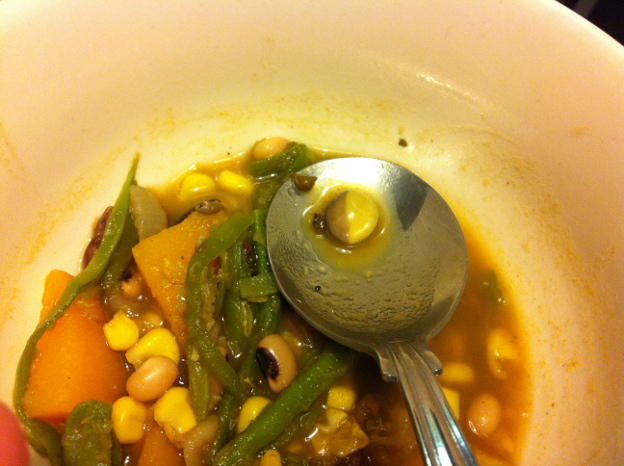
A cooked pea bean. Its distinctive markings and colours returned, albeit not as vibrantly as in its dried form.
It is strange that pea beans aren’t grown more widely in the UK. They are very easy to grow. We’ve been growing them for five years and never had any problems with them at all. Until last year we had always grown them in large pots, four or five plants around a wigwam of bamboo canes. As we had more space last year we started them in pots and moved them out into the vegetable patch once they were established. Wherever we’ve grown them they have always thrived.
Saving the seeds couldn’t be easier. French beans nearly always self-pollinate, so cross pollination shouldn’t be an issue. As a precaution it’s best to leave a few metres between this and any other French bean crops (they won’t cross with other beans such as runner beans or broad beans). Leave some typical looking pods on the plant (i.e. we don’t want to be saving pods with only two beans in) to dry. If the weather is too damp to allow for this, bring some mature pods indoors and hang them to dry. Once the pods are have turned parchment-like and the beans are rock hard, store them in a cool, dry and preferably dark place. Next year plant these to get your next harvest of pea beans. Any surplus saved beans can of course be soaked overnight and consumed. We have saved our pea beans this way every year and never had any cross-pollination issues.
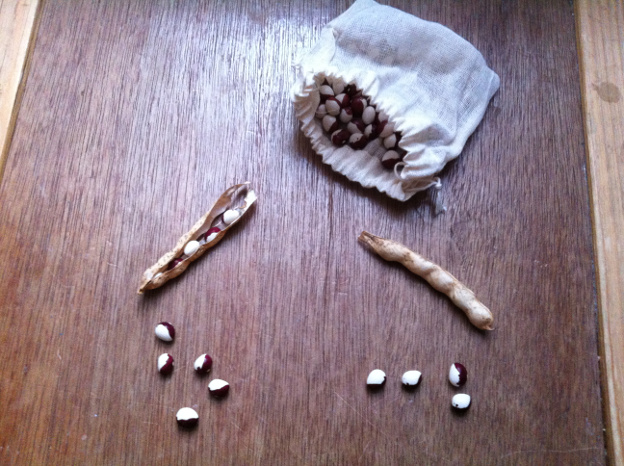
The source of this year’s crop – last year’s home saved pea beans.
Adding to the mystery of why pea beans aren’t more widely grown in the UK is the fact that they have been grown here for a very long time. They feature in Gerard’s Herbal, first published in 1597. They are listed as one of the interesting French bean varieties in Sue Stickland’s Back Garden Seed Saving book, where she says that one strain of them that was sent to the Heritage Seed Library traces its origins back the Second World War ‘Dig For Victory’ campaign. So they were grown as far back as the sixteenth century and as recently as the 1940s, and yet very few people seem to be familiar with them.
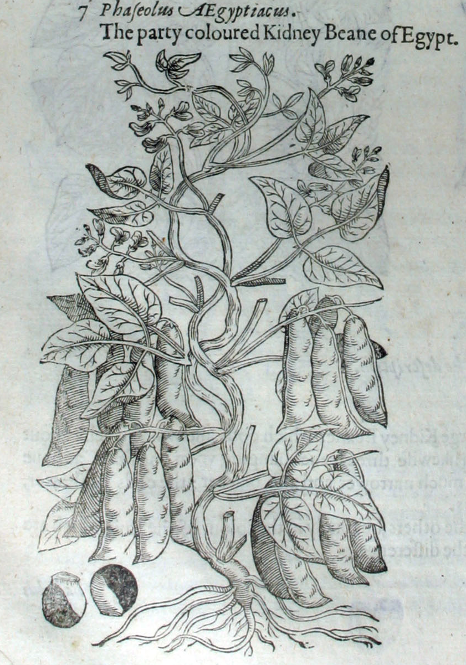
The Pea Bean in Gerard’s Herbal – a sixteenth century reference to this most striking bean. Image: www.BioLib.de
Everyone who has grown them at my suggestion and every review I’ve managed to find of them agrees that they are easy to grow, reliable, high yielding, very versatile and absolutely delicious. Added to that is the bonus that you only ever need one set of seeds and you can easily save your own (and thus truly become self-sufficient in them). So although I don’t know why they aren’t grown more widely, I do know that we shall continue to grow them and we are doing our part to spread the word. Give pea beans a try – your only regret will be that you hadn’t found them sooner!


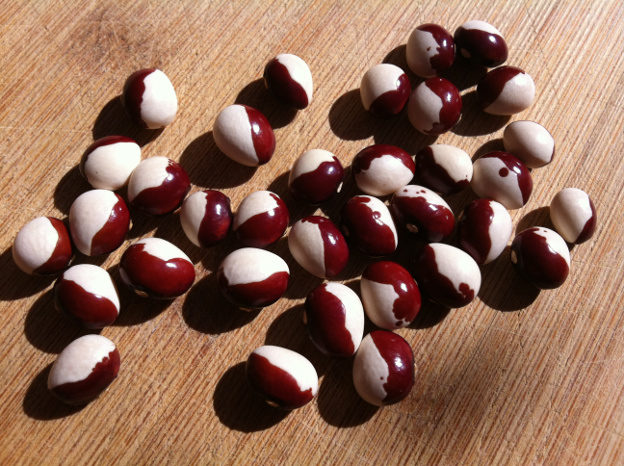
I’d read your blog last month and had been wondering where I could get my hands on some of these when I spotted a bag of them for sale in my local market today! Going to enjoy most of them in tasty stews then plant some out in the spring – can’t wait! Thanks for the article.
Hi Anna,
Thanks for the comment. A very good find at your local market! We’ve only ever seen them for sale online. How were they being sold, dried and shelled? I’m sure you’ll love them as much as we do.
Matt